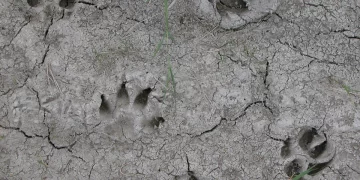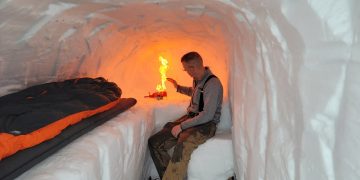In the wild, where civilization feels distant and nature reigns supreme, survivalists must rely on a combination of skills to navigate, find food, and stay safe. One of the most underrated yet crucial skills for any survivalist is the ability to read and understand animal tracks. The art of tracking animals may seem like a skill reserved for seasoned hunters or naturalists, but it holds vital importance for anyone looking to survive in the wilderness. From gathering food to staying safe and navigating your surroundings, animal tracks offer clues that could make the difference between life and death.
The Significance of Animal Tracks in Survival
When survivalists venture into the wild, they encounter various challenges, such as food scarcity, dangerous predators, and an unfamiliar environment. Animal tracks can offer important insights into all of these concerns, providing invaluable information about the ecosystem and wildlife in the area.
1. Food Source Identification
In the wilderness, knowing which animals roam the land can help survivalists identify potential food sources. The tracks of various animals like deer, rabbits, or wild boar can guide trackers to their feeding grounds or their routes between water sources and shelter. Understanding the shape, size, and pattern of different animal footprints will help you determine what species is present in your area, and whether it is a viable source of food.
For example, following deer tracks can lead you to a grazing area where you can set traps, find edible plants, or even hunt for food. Similarly, recognizing the signs of smaller animals like squirrels or rabbits can indicate an opportunity for trapping. Every footprint tells a story of the creature’s habits, and this knowledge allows survivalists to predict their movements and behavior.
2. Avoiding Dangerous Predators
Knowledge of animal tracks is not only about hunting or gathering; it can also help avoid dangerous predators. Tracks of larger predators such as bears, mountain lions, or wolves provide a warning of their presence in the area. By recognizing the distinct tracks of these animals, you can alter your path, move cautiously, or even find shelter to avoid an encounter.

In some cases, understanding the size, shape, and depth of an animal’s track can tell you whether it was recently in the area or if it’s safe to proceed. For example, fresh tracks from a predator could indicate that it is nearby and could still be in hunting mode. On the other hand, older tracks suggest that the danger has likely passed, and you may have a safer window to move forward.
3. Navigational Aid
Animal tracks can also serve as a valuable navigational tool, especially in areas with minimal human-made markers or trails. In the wilderness, following the tracks of animals can help you find water sources, locate shelter, or even discover hidden paths through dense vegetation.
For instance, many animals like deer or elk will follow well-worn trails between feeding and resting spots. These trails often lead to water, so recognizing and following them can guide you toward a reliable source of hydration. Furthermore, animals tend to stick to areas where they feel safe or where food is abundant, so their paths can lead survivalists to better areas for shelter or resources.
4. Predicting Weather Changes
While less commonly discussed, animal behavior as reflected in their tracks can also hint at changing weather conditions. For example, certain animals may become more active right before a storm or change their usual routes when there’s a shift in the weather. Recognizing these subtle signs and understanding the way animals adapt to weather changes can help survivalists prepare for any sudden shifts in their environment.
In particular, understanding how certain animals react to cold weather, rain, or heat can signal shifts that survivalists should respond to. The tracks of animals that suddenly avoid certain areas or seek higher ground might point to an impending weather change. Additionally, animals that become more sedentary or disappear into shelter could indicate that extreme weather is on the horizon, prompting the survivalist to seek shelter or prepare accordingly.
5. Tracking for Safety
For survivalists, understanding animal tracks is about more than just being able to recognize the species—they can also serve as a means of keeping track of your own safety. If you’re not familiar with an area, following animal tracks can help you assess the safety of your surroundings.
If the tracks show signs of aggression—such as deep claws or disrupted ground—it may indicate that the area is more dangerous than anticipated. Conversely, seeing tracks of herbivores like rabbits or squirrels can signal that predators are not frequenting the area, allowing for a safer environment to settle in.

Types of Tracks Every Survivalist Should Know
Not all animal tracks are the same, and the better you are at recognizing the subtle differences, the more you can use them to your advantage. Here’s a breakdown of some common tracks and their significance for survivalists.
1. Mammals:
Mammals are one of the most common animals survivalists will encounter. Their tracks range from tiny rodents to large carnivores.
- Deer: Deer tracks are narrow and pointy, with two hooves forming a “V” shape. These tracks can often be found near water or forested areas and can lead to important food and water sources.
- Rabbits: Rabbit tracks are small and round, often with a distinctive hopping pattern. These can help you locate rabbit burrows or feeding areas.
- Bears: Bear tracks are large, round, and distinctive, with claws visible. These tracks are often seen in muddy or forested areas and can be a sign of danger.
- Predators (Wolf, Mountain Lion): These tracks are typically larger and can show signs of sharp claws and deep impressions in the earth. Their tracks are often spotted in areas where prey animals like deer congregate.
2. Birds:
Bird tracks tend to be smaller and can offer unique insights into nearby food sources or threats.
- Turkey: Turkey tracks are distinctive, with three long toes at the front and one at the back. They’re often found near forest edges and open areas.
- Geese: Geese tracks are often wider, and their webbed feet leave a unique imprint in the mud or snow. These tracks can lead to water sources or wetland areas.
3. Reptiles:
Though less common, reptile tracks can also be important indicators in certain environments.
- Snakes: Snake tracks are unique in that they leave no visible footprints but can create a visible trail in sand, dirt, or snow. Recognizing these can indicate the presence of venomous or non-venomous species in the area.
- Turtles: Turtles leave a broad, flattened track, which can be useful in identifying nearby water sources, particularly in desert or semi-arid environments.
How to Read and Interpret Tracks
Reading animal tracks is a skill that combines observation, patience, and knowledge of the terrain. A survivalist needs to know how to interpret the subtle clues left by animals. Here are a few tips:
- Examine the Size and Shape: The size of the track indicates the size of the animal. A small, round track may belong to a rabbit, while a long and narrow track could belong to a fox or coyote.
- Look at the Depth and Condition: Fresh, deep tracks in soft ground may suggest that the animal is nearby, while shallow or faded tracks indicate older prints.
- Note the Gait and Pattern: The way an animal walks or runs can give clues to its behavior. For example, a predator’s tracks may show a more deliberate, purposeful stride, while prey animals may have more erratic patterns as they escape danger.
- Contextual Clues: Look around the tracks for signs of activity, such as scat, broken branches, or disturbed ground. These contextual clues can help confirm which animal left the tracks and what it was doing in the area.
Conclusion
For survivalists, the ability to read and understand animal tracks is far more than a curiosity—it’s a practical, life-saving skill. Tracks provide insight into food sources, potential dangers, and safe routes through the wilderness. While the art of tracking may take time to master, it’s a skill that offers undeniable benefits, enhancing your ability to live off the land and stay one step ahead of nature’s challenges.
Understanding animal tracks opens a window into the hidden world of the wild, where every print in the soil is a message—whether it’s the call to hunt, the warning of a predator, or a guide to the next water source. For survivalists, learning to decode these messages could mean the difference between thriving and merely surviving.























